Examination of the use of drones in city logistics, exploring the modeling issues related to their application
The research related to the concentrated sets of delivery locations and modeling was partly supported by the EFOP-3.6.3-VEKOP-16-2017-00001: The research was supported by the Hungarian Government and co-financed by the European Social Fund through the project “Talent management in autonomous vehicle control technologies” (EFOP-3.6.3-VEKOP-16-2017-00001).
Experts currently working on the project: Dávid Lajos Sárdi, Krisztián Bóna
Students currently working on the project: Dóra Kovács (BSc student), Petra Kovács (BSc student)
Students previously working on the project: István Font, Márk Kerekes
Start of the project: September 2020
Examination of the concentrated sets of delivery locations is an important new approach to researching city logistics systems. These sets, where in a small area, numerous delivery locations can be found with huge demands and customer flow, such as shopping centers, markets, or shopping areas. These systems handle numerous small, light packages, transferable by cargo bikes or drones, which are opening new possibilities for these small transport devices in the case of home deliveries and deliveries between stores. For these reasons, it would be essential to enquire how to fit drones into the innovative gateway-based supply systems in the case of the concentrated sets of delivery locations, which tasks they could do, and how they would patch into a model with road or railway transport modes in application. Of course, the autonomous application of drones in such systems gives important questions from the legal side. However, from an effectiveness, human resources, and cost point of view, this is a huge opportunity.
In this project, we are currently researching systems applying drones and studying the joint literature. In the coming months, our main task will be elaborating on system concepts using drones.
It is worth mentioning here that there was research conducted earlier about drones by the department’s Logistics Drone Technology Research Group. From the Department of Material Handling and Logistics System, Krisztián Bóna, Marcell Bertalan, and Bálint Bertalan take part in these studies, as students Roland Juhász, Bálint Mészáros, and Márk Kerekes were concerned earlier with these tasks. The research focused mainly on intralogistics applications, resulting in multiple thesis works and a paper.
The project aims to examine the possibilities of using drones for last-mile delivery tasks and to find out if drones could be a viable alternative for road transportation concerning small and light packages. The first step was to enquire about drones’ current successful extra- and intralogistics applications. In the field of intralogistics, there have been examples of functioning systems for several years, and their development and deployment are still ongoing, while in the area of extralogistics, the first functioning systems are only just starting to be implemented, and there are still no functioning solutions in Hungary. The cause is that there are a lot of unanswered questions about the open-air application of drones. These challenges can be sorted into three categories: technological, legal (regarding regulations), and operative type of questions. Suppose we want to ensure that it is worth implementing high-tech drones in a given system. In that case, we need to build a model that can provide a reliable estimation for the future by simplifying the environment. However, in our opinion, there are still too many unanswered questions to build models with sufficient accuracy, which is why a research project was started to investigate the modeling challenges of supporting urban freight transport tasks with drones. The research showed the technological differences between drones used in extra- and intralogistics, thus highlighting the technological difficulties. The most significant legal barriers were grouped, and the challenges related to modeling were identified, namely:
-
- accuracy of input data
- oversimplification of flight time
- air traffic control
- operation in swarms (see the following figure)
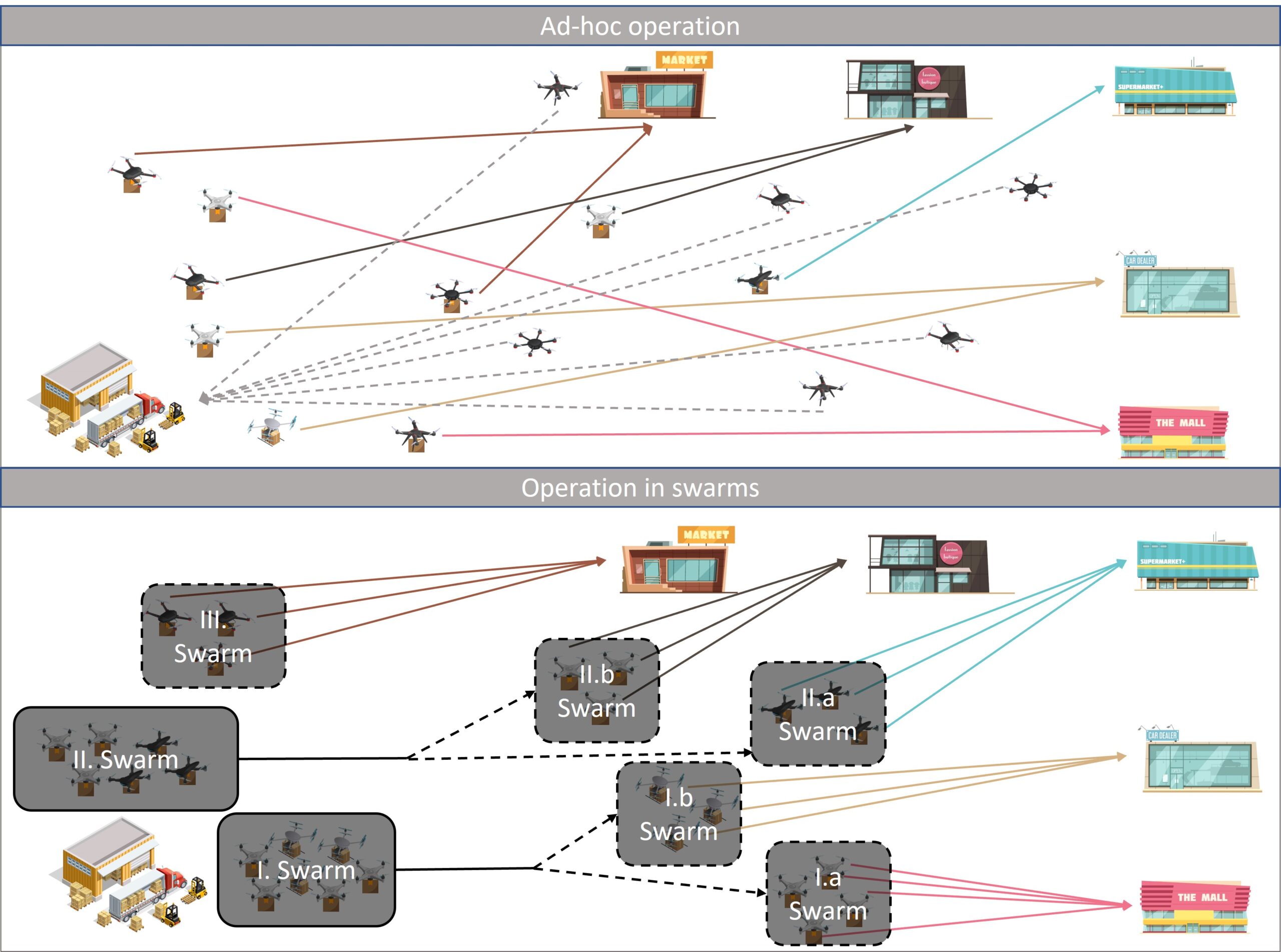
Operation in swarms
In a previous step of the research, we needed to build models to compare the different transportation methods. With these models, it was possible to simulate the behavior of the city logistics system. In the first step, we defined the inputs and conditions. Among these conditions, we defined the last-mile nature of these deliveries, the requirements of the drones, and the area inspected in which the data needed is generated. With these conditions, a system using drones got modeled too.
Although the function of these two delivery systems is basically the same, the base of their operations is quite different. We had to keep the system exact and comparable in forming road models. With these in mind, we presented two scenarios. With drones, home delivery has tremendous obstacles, so we needed an indirect solution, the application of pick-up points. In the second scenario, part of the road transport serves pick-up points, so visiting every delivery location is unnecessary.
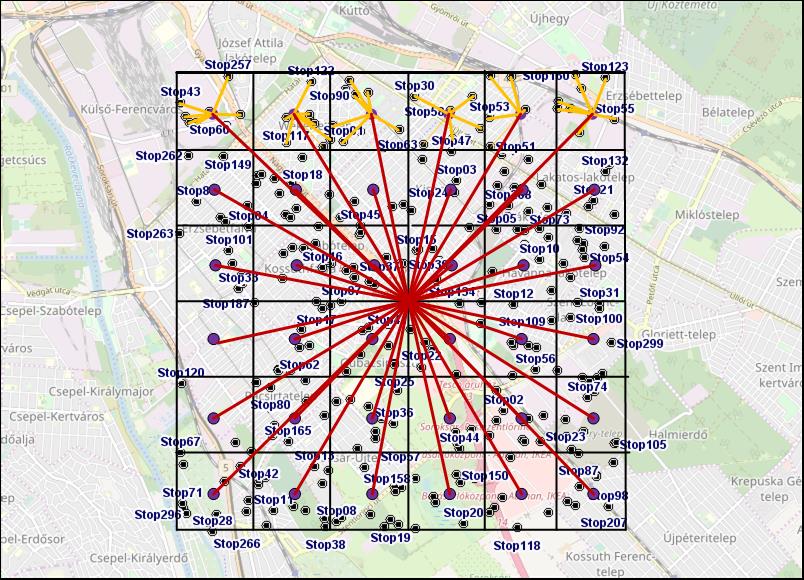
The delivery model with drones
With systems applying drones, it is important to know how many drones should be used to satisfy the requirements. For this, a unique model was built, which inspects delivery tasks and mass service systems. If we fill these models with data, it makes it possible to examine delivery tasks via simulation. The results of these were analyzed through different criteria. These criteria were the costs and pollution of maintaining these systems.
As the next step from the autumn of 2020, we started to examine the usage of drones in the city logistics system of concentrated sets of delivery locations. We have performed these tasks so far:
-
- The overview of working and pilot systems using drones in city logistics, gathering system concepts, and relevant transport drone technology info
- Examination of the previous department research, looking for usage and improvement possibilities.
- Literature review concerning drones in logistics
- Data analysis of concentrated sets of delivery locations (one market in Budapest, four shopping centers, and the “Váci utca” shopping area), the possible areas of application for different sizes, types, and capacity delivery drones (for supplier deliveries, home deliveries, deliveries between stores or to maintenance, etc.) in city logistics systems of concentrated sets of delivery locations
- Highlighting possible areas of application, elaborating city logistics system concepts (dedicating the role of drones in previous solutions with road vehicles, cargo bikes, railways, and waterways)
- Examining the possibilities of adapting models made on earlier research for city logistics systems of concentrated sets of delivery locations; exploring the possibilities of adapting models made for geometrical model-based cargo bike city logistics system
- Summarizing the results, the definition of the following steps
- Unraveling and defining the participants of the supply chain, deliveries from a consolidation center, deliveries between stores (between concentrated sets of delivery locations or single stores), home deliveries, or serving pick-up points
- Identifying the critical elements of the drone-based supply chains
- Introducing the concept of drone mini-hubs
- Developing the technological concept for drone mini-hubs, identifying current solutions and relevant technology options, compiling and analyzing technology versions
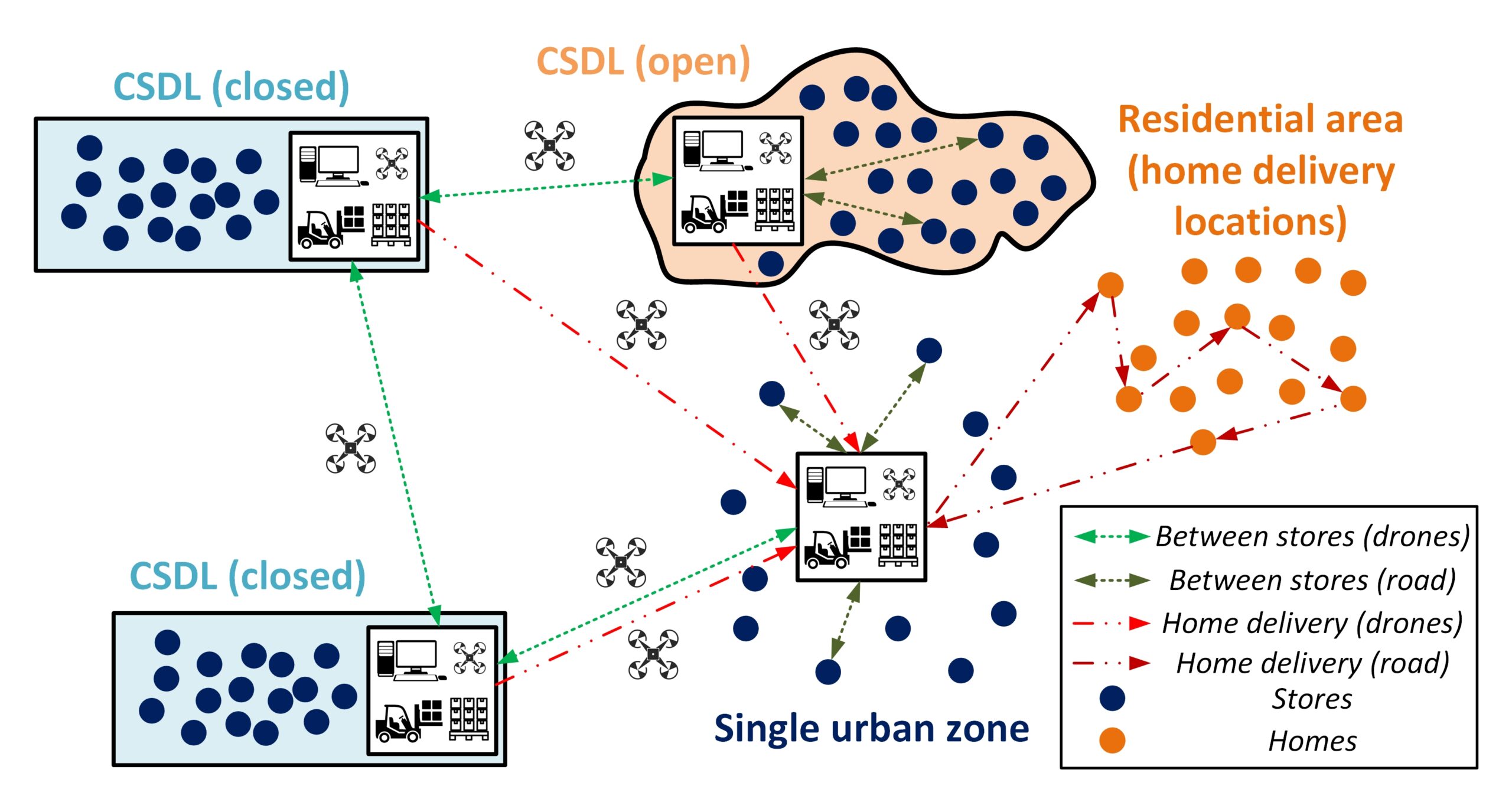
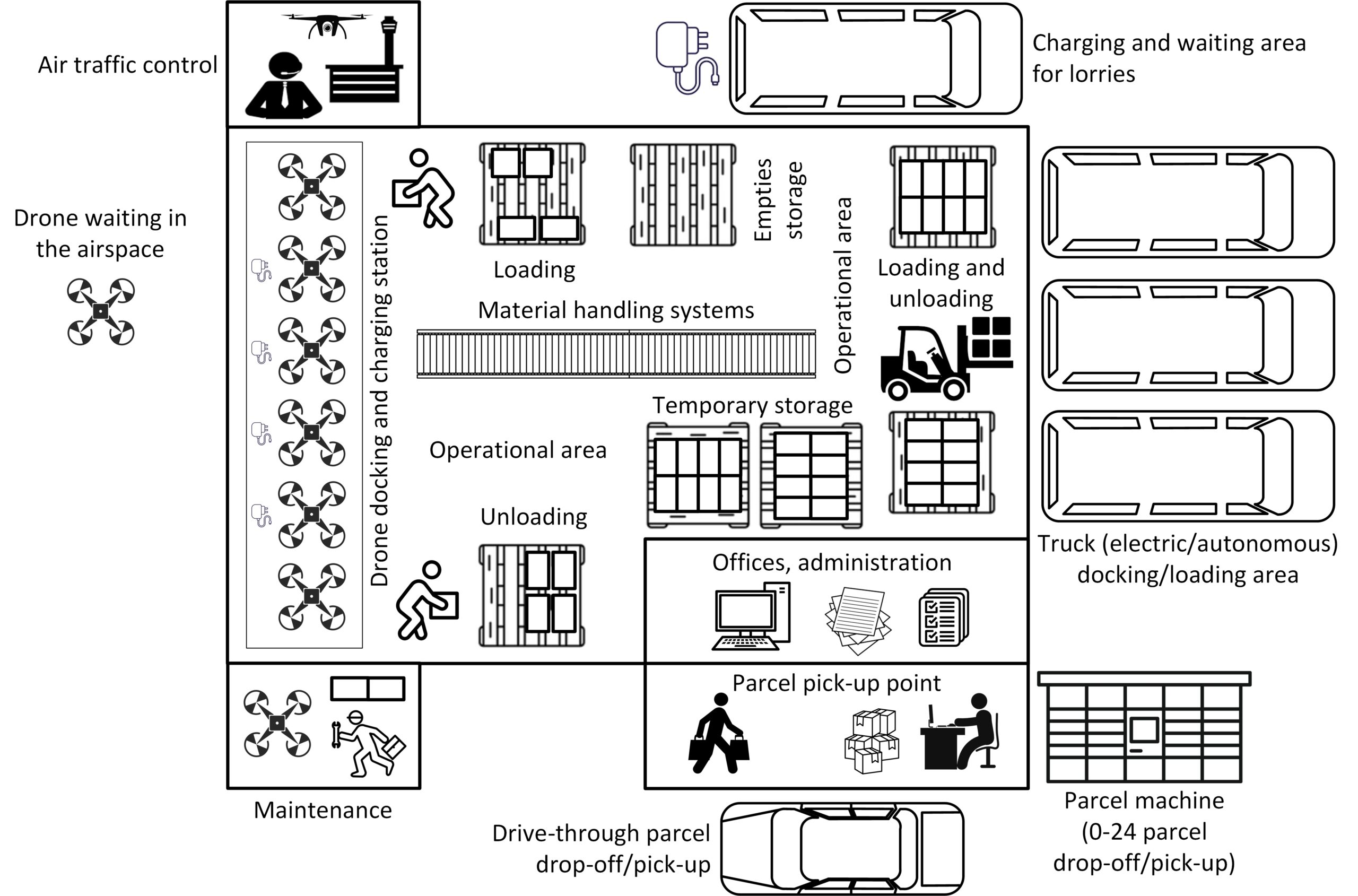
Location and technological concept of the drone mini-hubs
In the project’s next phase, we started working on traffic management solutions for drones from the spring of 2023. At that time, we were looking at how traffic management issues could be addressed in a few decades when all complex logistics providers involved in parcel delivery will likely be using drones to deliver at the last mile of the supply chain. We hypothesized that using swarm-like traffic management logic could be a winning strategy for handling a single drone load, and this was the focus of our work in this phase. Organizing drones into swarms is worth looking at the living world, as movements involving multiple individuals based on some regularities have been observed in many species and have been exploited to solve complex problems. Although many organisms have this kind of movement in their genes, drones need to learn it, communicate with each other, and coordinate their movements. Many other unanswered questions (e.g., swarm size, swarm formation rules, join-disjoin problems, etc.) must be addressed to these movements.
To treat individual drones as a swarm for as long as possible, their destinations must be nearly identical. Accordingly, we see the future in delivery to parcel lockers/machines (or to the drone mini-hubs we have previously explored) by breaking a large settlement into smaller swarms, primarily based on range, and always organizing and launching a drone swarm based on the actual delivery tasks. Specialized parcel machines capable of serving drones are well distributed in the city, which requires depots from which we launch the drone swarm with sorted parcels using, for example, a multi-criteria decision model. After transactions are completed at different times, the drones meet at a given point, and the swarm is reorganized and flies back to the depot.
In this phase of our research, we looked for possible solutions to the decision and technological problems that arise in connection with the steps of the former process. Looking around at the issues, we can say that the implementation of drone-assisted mass transport of goods is still a rather novel and seemingly utopian idea that has been explored a little. This raises several questions that require experiments, pilot systems, further research, and the involvement of different disciplines. The traffic management framework we have created contains several new ideas and challenges that could give more munition for the research that will follow.
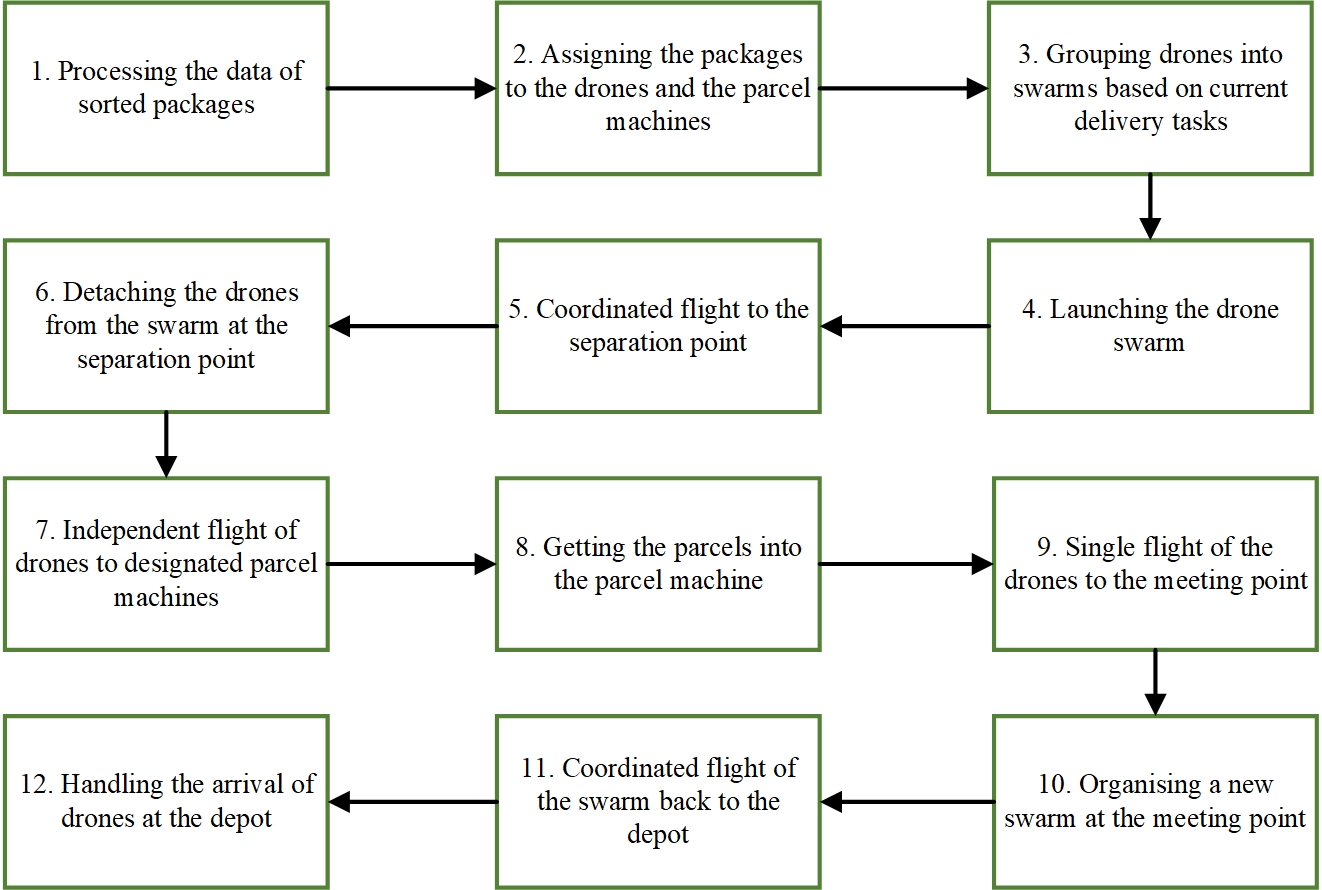
Operational logic of the swarm traffic management model
Significant documents related to the project
Dávid Lajos Sárdi, Krisztián Bóna, PhD. Application possibilities of delivery drones in the case of concentrated sets of delivery locations in Budapest (2021).
19th European Transport Congress of the EPTS Foundation e.V, Maribor. – Conference proceedings: European Green Deal Challenges and Solutions for Mobility and Logistics in Cities. Edited by Tomislav Letnik. pp. 127-142.
URL: https://www.fgpa.um.si/wp-content/uploads/2021/12/Conference-Proceedings.pdf
ISBN: 978-961-95633-0-4
Dávid Lajos Sárdi, Krisztián Bóna, PhD. Developing the concept of drone mini-hubs in the city logistics system of the urban concentrated sets of delivery locations (2022).
Hungarian Logistics Association – Logistics Yearbook 2023, pp. 88-96.
DOI: 10.23717/LOGEVK.2023.8
URL: https://drive.google.com/file/d/12BnQndqiqM-Ip1w-qyHzaS31Mss674CF/view
ISSN: 1218-3849